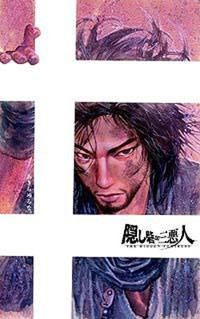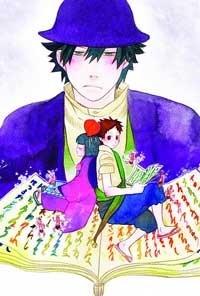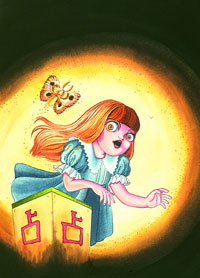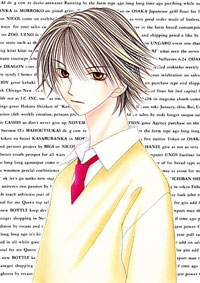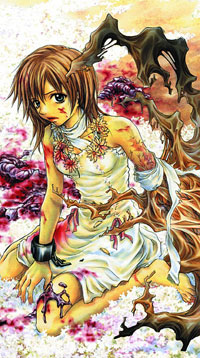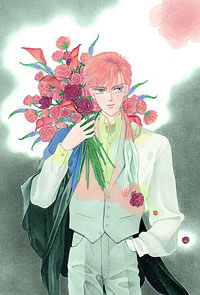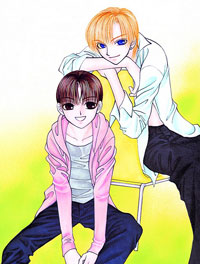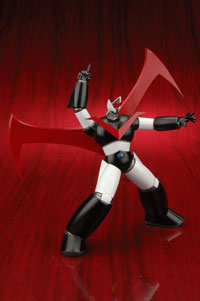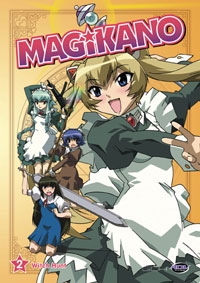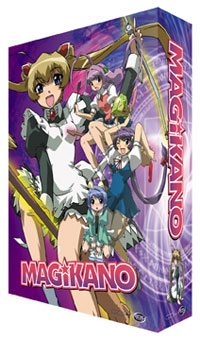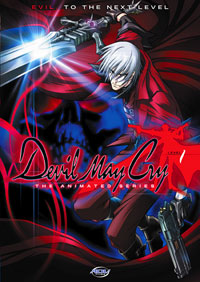 Logo handmade by Bannister
Column by Scott Green
Logo handmade by Bannister
Column by Scott Green

Resource Spotlight: The Art of Nausicaa of the Valley of the Wind Watercolor Impression by Hayao Miyazaki Released by Viz Media
"Hayao Miyazaki" has long been the stock answer to any question regarding the artistic potential of anime as well as any question regarding the potential for anime to appeal to audiences beyond the enthusiast crowd. To a large extent he's a marble statue in the mind of many fans. While his work has been academically deconstructed, there's also an untouchable, widely accepted magical aura around his work. Art of Nausicaa is a gift to Miyazaki fans, largely because it holds a magnifying glass to both his output and his creative process. The ecological fantasy epic Nausicaa established the framework for Miyazaki's Ghibli movies, as a prototype for the production and the form of the movies for which he'd become internationally recognized. The 1984 film was his vehicle for building a team and moving from studios like Topcraft and Toei to establish Ghibli. Two years earlier, the anime was predated by a manga version that Miyazaki labored with off and on for 13 years, making it by far the renowned director's longest work of manga. This art book affords a peak into this landmark in Mazaki's development. The oversized hard cover is divided into four parts. It begins with "for MANGA", a collection of watercolors produced for the Nausicaa manga; for covers, promotional material and the like. Each piece is accompanied by retrospective thoughts from Miyazaki and a block of factoids, picture name/size, first appearance, subsequent appearances and character goods (merchandise that featured the particular piece of art work). Except for a few maps, info/design sketches, and a few pieces that focus on antagonist Kushana, these are mainly iconic images of the titular character. The second section "for MOTION PICTURE" features design work, generally for places such as the Valley of the Wind itself. The latter half of the chapter breaks down the anime film's classic introduction, which began with a recounting of a long ago apocalyptic disaster in a tapestry motif, that would resolve into Nausicaa herself landing a glider in the midst of a desolated world. This design work includes frames that didn't make it into the movie. Finally, "the way to Nausicaa" features text and images of aborted not-quite-Nausicaa stories in the development of Miyazaki's classic. The book's imagery is not quite as expansive as you'd expect a Miyazaki watercolor collection might be. The intentions of the manga images are to draw the attention of a manga-shelf peruser. Even the more dynamic instances look posed, and Miyazaki's comments are clear about his discomfort with the format. While these are attention grabbing, Miyazaki labors, not always successfully to make the images look natural rather than staged. As Miyazaki mentions, some of these images either are not true to the situation or are not true to the character. These are images that are designed to look striking in isolation, on a cover, a poster or a t-shirt. A Miyazaki work like Totoro or Kiki would have the room for a cozy, close view of the characters. These posed snap shots are add odds with the epic scale of Nausiccaa. Collected, the lack of a horizon to horizon view is felt. It's always stuck on the periphery of the intensely realized world creation at which Miyazaki excels at, in his body of work in general and in Nausicaa specifically. The most fascinating and disappointing factors in the later segments are their rawness. Intellectually, it's a heady treat to see the building blocks of a Miyazaki movie. Viscerally, for an art book, it doesn't have the impact you might expect from Nausicaa. The fragmented or preliminary images tell a story of Miyazaki's creative process rather than capturing the scale Nausicaa. The strongest cumulative effect of the art work itself is what it says about Nausicaa's eponymous heroine. There is a discussion of the character's beatification throughout the story particularly the manga. Shown constantly throughout the art book, Nausicaa looks literally iconic, and there's something magnetic and soulful about the character that would be compelling, even if you hadn't experienced the story through the anime or manga.
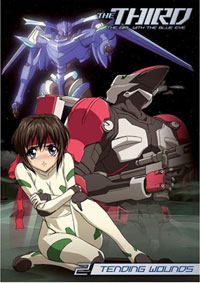
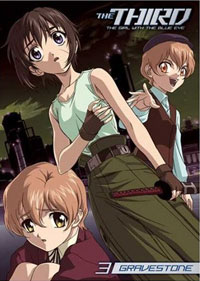
Anime Spotlight: The Third: The Girl With the Blue Eye Volumes 2 and 3 Released by The Right Stuf International
The Third stands out by degrees. It puts a girl and a tank into a war devastated wasteland, where they contend with giant bugs, world manipulating, three eyed elves, buried super-weapons and the like. All of the tropes of anime and general action sci-fi are lined up, staring complete derivativeness in the eyes. It probably does not help to point out that the heroine frequently settles conflicts through the integrity of her good-hearted soul. Like Naruto, or other popular heroes, the protagonist is gifted with the ability to bring others around and convince them to see the potential in the protagonist and themselves. Yet, the Third works hard to find ways to arrive at that point honestly. There's something winning in that its heroine is genuinely cute owing to her emotive youthfulness rather than cynical over design, and her adventurer's broad competence. As the Third proceeds from its introductory episodes, it takes on a Trigun crossed with Slayers feel. Though the 24 episode series aired on Japanese TV in 2006, the tone and pacing recalls anime tv series from the mid to late nineties. In part, this is due to its origin as a light novel series, serialized in Monthly Dragon Magazine, which was the source of Scrapped Princess and Slayers. The amount of built up background to work with, the fact that the background is prose and not shonen manga, and what, in the current landscape, is a moderately high episode count complement each other, and allow The Third to unfold at its own pace. Like the previously mentioned works, early on, the Third establishes a strong sense of who the principal characters are and what their unique environment is about, but it doesn't need to aggressively push its agenda. Without giving the impression that the series has been avoiding consequential matters in its early episodes, it has taken a wide arc in the descent towards story points. Early episodes of The Third were predictable, and as its world has expanded in later episodes, that hasn’t changed much. However, the unsurprising plot of the anime is offset by a combination of a sense of wonder and an unmistakably sentimental outlook. There's an episode that revolves around protecting an emerging queen-giant-ant before she can fly away to safety from rivals. As unspectacular as protect-the-ant plotting might be, The Third's bittersweet tone is a distinguishing characteristic for the anime, and because it isn't constantly rushing, that mood is allowed to permeate throughout the series. Besides possessing what could pass for sincerity, the Third is endearing for taking the stance of the above average performer that succeeds over the long haul. It's not the best anime out there. It is not contending to be a favorite, and that allows the series to work with familiar elements without looking like a hyper-cynical manufactured product. Like Slayers and before that Dirty Pair, it is able to work with a potentially recognizable genre framework, and provide "fan service" by paying tribute with a complementary variation on the theme. Because it doesn't go out of its way to nail the viewer, it avoids the baggage that is picked up by rehashes for the uber-hard core. While characters are tailored to appeal to sci-fi anime fans, they aren't overdone to the extent that they become moe, tsundere or the any of the really pandering models. From an implementation level, the series is a mixed success. There is a device in which story-teller voice overs speak to what is plainly evident on screen. Director Jun Kamiya had to have been trying to produce some effect with these, but given that the desired response isn't even clear, it's safe to save that the voice overs failed in their purpose. Similarly, the anime is limited in its action animation. Though there are some obvious short cuts (and off model characters even make it into the preview after the final episode of volume 3), that's not the most pronounced problem. It's very capable of animating fluid anime-samurai style fight scenes. The posturing, positioning and sprinting acrobatics of the face off/draw/rush sword work is captured with exhilarating excitement. In terms of staging, the anime shows eye-catching flexibility. It moves the fights from star lit deserts to sun-set hued industrial landscapes and in all cases, the lighting and the presentation are top notch. Beyond these quick sword-swipe exchanges, the anime displays limited imagination or limited ability. First, it only has one speed for this sword work. The heroine fights her doppelganger. The heroine is shoeless and generally unprepared. The doppelganger is ready. When they go at it, there's no difference in movement. Then, beyond the sword-fights, the anime runs into the problem of un-reality that looks cool versus unreality that looks sloppy. There's a busty woman support character who postures in a manner that suggests she studied the some sort of kung fu/jeet kun do. However, when it comes time for her to put on the Bruce Lee, it's mostly just repeatedly throwing the same punch from her shoulder. Though there's a consistent presence of mecha in the anime, there is little mechanized action. The tank moves a bit, fires a bit, but has yet to be put into a complex action sequence. Humanoid robots are dispatched with little visual fanfare. Perhaps most telling in the reluctance to animate mechanical fights is that a particular robot is built up as a substantial antagonist, and then in his/its first encounter, it taunts the heroine and flies off. In the actual throw down between the two, there's little spectacle.

Anime Spotlight: Wallflower Volume 1 Released by ADV Films
Do most people have an elderly relative who had a habit of leveling some awful, generally, bigoted slur against acquaintances, then cap the invective with "ah, well... God bless them?" My great, grandfather, I think he was from the backwoods between Poland and Russia and didn't speak much English reportedly referred to his neighbor/friend as "Frank the Guinea," then followed the cussing with "God bless him." You don't need to be someone who declares that CLAMP's work is "shoujo shit" to take pot shots at Wallflower. It is a noteworthy production, directed by Shinichi Watanabe, aka Nabeshin, who, with his in-series cameos, seems intent on becoming a celebrity, and animated by the venerable Nippon Animation, but it's also an enthusiastic mess. It's philosophically scattershot. It's too enamored with its own gags. If the character genders were reversed, it would be the nTH one guy, multiple girls relationship comedy, and entirely ignorable. But, despite shoujo's dominant role in the North American manga market, few legitimately shoujo anime are being, or have been, released in the US. That's especially true if you don't count anime that are not technically shoujo, such as Azumanga Daioh, Kamichu and like. For that if no other reason, "God Bless..." Kyohei Takano, Takenaga Oda, Yuki Toyama, and Ranmaru Morii are four handsome, fantastically well groomed teenage guys renting rooms in a mansion. In terms of differenciating personality traits... well... Kyohei is kindof the alpha, and he's always looking for financial angles since he has trouble keeping jobs due to attractivness provoked sexual harassment. Takenaga is a bit more serious, a bit more nonplussed. Ranmaru is a bit more amorous. Yuki is a bit younger, and the gag is that during the exploits of the crew, he's always the one who has to cross-dress. The jet setting, love seeking owner of the mansion informs her four tenants that she will stop charging rent if they can turn her niece into a "proper lady" (it's "Yamato Nadeshiko" in the original Japanese, and the series original title was Yamato Nadeshiko Shichi Henge, this has very traditional connotations.) It turns out that the subject of this make-over is Sunako Nakahara. A few years ago, Sunako received a blunt rejection after confessing her love to a classmate. After that, she became decidedly introverted. Her interests turned to horror and the macabre. With her bangs growing out to cover her face, and clad in dirty, loose fitting clothes, she took on the appearance of a Japanese horror "dead wet girl" spirit. Confronted with attractive "creatures of the light", who make it their business to pay close attention to her, Sunako does not react particularly gracefully. Wallflower is thoroughly a situation comedy, and not one designed to reflect credible experiences. As soon as the scenario is introduced, Sunako's aunt hops up onto a rope ladder to be carried off by a squad of helicopters. There are four guys who exactingly conform to the narrow featured, feminine looking bishonen aesthetic. In the opening episode, there is a preamble first, but going forward, the anime hits with an opening credits sequence featuring this quartet naked. They hover around Sunako, getting embroiled in various encounters that would be difficult for an introverted young woman, from the eventful, like school festivals, to the contrived, such as modeling for renowned photographers or kidnappings. Each episode reaches some point where the boys are threatened or confronted. The righteous anger, provoked by the "creatures of light" being harmed or disrespected is enough to cause Sunako to hulk up, and adopt the demeanor of a Yamato Nadeshiko avenging angel. So, Sunako is a shlumpy coach potato who likes watching gory movies and talking to her gross anatomy mannequins, but when Kyohei is abducted by a private club, she puts on a kimono and adopts perfect manners, before shedding the disguise in favor of a Nazi she-wolf get-up and chainsaw. Other than the jokes about Sunako's resemblance to a vengeful spirit and her fascination with ghosts and goblins, or running gags, such as Yuki being pressured to cross-dress, the humor is a function of situation and presentation rather than interactions. For an, in theory, character driven shoujo work, the stories are surprisingly reliant on external forces. Starting with Sunako's aunt, and continuing with ganguro bullies, criminal dilatants and swishy photographers, the catalyst for the episode stories is nearly always some arch caricature. And, Nabeshin is drawn to that quality in the series. He's energized by the visual humor of the manga, particularly its gags. As in previous comedies, the director inserts himself into the anime through cameos. This time, a speedo-clad, deep tanned Nabeshin-pair introduces beauty tip interludes leading up to the climax of most episodes. There's a glee to the anime when Nabeshin is able to feature jet packs, impossibly long limousines, or extravagantly odd characters, such as a loli-goth chorus who wave octopus arms and curse "loli-loli-loli... goth-goth-goth." Dinners full of cute waitresses fawn over the boys, turn into silhouettes, and spout fountains of blood out of their noses in excited arousal as the building blows up. Even conventional conversations have exclamation marks dancing above the characters' heads, and it is noteworthy that given the tone of the anime, these invasive visual notes aren't distracting. If you can't get enough Nabeshin, Wallflower is sufficiently well produced that you will not be entirely disappointed. For an Excel Saga fan, it's more satisfying than a Tenchi Muyo: GXP or eX-Driver: Danger Zone. If you're a bishonen fan, the anime makes it a point to deliver early and often. Beyond that, Wallflower isn't for everyone. That's true of most anime, especially as the market continues the trend of slicing up groups of enthusiasts into increasingly narrow divisions. Personally, I find it easier to justify a divisive mecha anime, Godannar for example, than shoujo. If that were reversed, this might have been a glowing endorsement of Wallflower. At least among fans of manic anime comedy, the involvement of Nabeshin does lend Wallflower some cross-over appeal, but it's limited. Sports anime demonstrates that well constructed anime characters can connect to an audience even if the audience has no pre-existing interest in the subject. Basketball and American football earned a following in Japan because popular anime/manga featured the sports. Yawara! A Fashionable Judo Girl, the story of a girl training to compete in judo at the 1992 Barcelona Olympics isn't an ideal point of comparison for Wallflower since Yawara is a manga that concerns a female character written by a man, published in the male oriented seinen anthology Big Comic Spirits. But, it does illustrate the flaw with Wallflower. In that case, that zany , some times over exaggerated comedy about a highschool girl was universally entertaining, because it was credibly build around understandable, likable characters who possessed concrete outlooks. For Wallflower, character design is situational and personalities are situational. Sunako is constantly changing shape from super-deformed, sexless blob, to shlumpy geek, to beautiful avenger, to a horror movie apparition, to an elegant ideal. After the rejection preface, as soon as she is introduced, the character is forced into a screw-ball Pygmalion. In this process, she has no real form and the particular form she takes on at a given moment is always in service of the arc of the episode. While horror obsessions are noteworthy, the anime doesn't really offer a read as to whether this particular interest is a shell or a real identity. The ambiguity concerning what is the true Sunako could be intriguing, but the narrative doesn't seem to have decided and doesn't seem interested in deciding how to weigh in on the conflict. Though it is potentially a provocative issue, Wallflower does not display any opinion on pressures put on Sunako either. At one point, the guys berate Sunako for not cooperating with their make-up efforts, accusing her of selfishness. There's no retort that A) she never asked for, or approved of their help. B)the motivation is to earn free housing in a mansion. It's not like they picked out a socially needy charity case. Is this part of the "Yamato Nadesico" ideal? As long as the situation progresses, the narrative doesn't seem interested in exploring that issue any more deeply. Sunako isn't the hapless flotsam that male leads of male oriented relationship comedies tend to be, but she isn't commanding her destiny either.
Upcoming Sequels
A third season of fantasy relationship comedy Zero no Tsukaima (Familiar of Zero) has been announced. The series, the first season of which was licensed by Geneon for North American release, follows a Japanese boy who is accidentally summoned as the familiar of a girl wizard-in-training. A third season of the murder mystery visual novel game franchise turned anime Higurashi no Naku Koro ni (When They Cry) is in development. This series was also licensed by Geneon, but three volumes of the first season was released before the company left the North American distribution business. Anime News Network details a gimmicky announcement that reveiled that the season of hit anime The Melancholy of Haruhi Suzumiya has been "cancelled" in favor of project animated by Kyoto Animation, directed by Yasuhiro Takemoto (Full Metal Panic! The Second Raid, Full Metal Panic? Fumoffu, Lucky Star) and supervised by the character Haruhi Suzumiya. The site references the fourth light novel in the original series The Disappearance of Haruhi Suzumiya. Less noteworthy, a second season of Kyouryu King (Dinosaur King) will start on Japanese TV on February 3.
Previews
Newsarama has images of the upcoming Justice League: The New Frontier, due out on February 26th. With a Takeshi Miike live action Yatterman movie in the work, a site has been launched for the new Yatterman TV series. Trailers can be seen here Kotaku has the trailer for the CGI Resident Evil: Degeneration movie. A trailer for Warner's North American release of Appleseed: Ex Machina is online here Concept work for Imagi's Gatchaman was included in an IESB interview with director Kevin Munroe A Japanese site has been launched for Kurogane no Linebarrels A Flash trailor for L the proLogue to Death Note: Rasen no Trap for the Nintendo DS is on the Japanese site.
Finally, "Ponyo On A Cliff" Info
Ghibli World has a summary of the long awaited plot and development e-mail for the next Studio Ghibli/Hayao Miyazaki film here. Studio Ghibli president and producer Suzuki Toshio mentioned that inspiration include Lev Atamanov’s Snow Queen, in terms of structure, and the Japanese Rip Van Winkle, Urashima Taro, in terms of story. The pre-Ghibli, Shinei Animation work Sougen no Ko Tenguri (Tenguri, the Boy of the Plains), an animation based on a story by Tezuka Osamu is being released for the first time on December 21. Speaking on Ghibli, the British, 2 disc DVD release of Goro Miyazaki's Tales from Earthsea will hit on January 28th for £19.99. Disc 1 Extras: English Dub or Japanese with English Subtitles / Storyboards Disc 2 Extras: Making Of / Trailers (11 mins) / NTV Special (44 mins) / Behind the Microphone (47 mins) / Studio Ghibli trailer reel Tech Specs: Cert: PG Feat. Running Time: 115 mins approx Region 2 Aspect Ratio: 16:9 Anamorphic Colour PAL Dolby Digital 5.1 Cat No: OPTD1083 Japanese with English Subtitles / English Dub RRP: £19.99. The anime adaptation of Ursula Le Guin's novel has not been announced for North American release due to Sci-Fi Channel's hold on the property rights.
Inoue Creates Kurosawa Poster
Japan Zone points out that manga artist Takehiko Inoue (Vagabond, Slam Dunk) has an illustrated a poster upcoming remake of Akira Kurosawa "Kakushi Toride no Sanakunin," also known as The Hidden Fortress. Directed by Higuchi Shinji, the movie is due for theatrical release in Japan on May 10.
Tezuka’s Phoenix for the DS
ViaMangaBlog, Compile Heart seems to be working on a visual novel/internative story retelling of Osamu Tezuka's Phoenix for the Nintendo DS.
April CMX Manga Releases
DOROTHEA VOL. 1 Written and illustrated by Cuvie In the medieval town of Naudars, albino children hold a revered and protected status. Dorothea is one of these children and she has always wanted to see the world beyond her cloistered existence. When Naudars is attacked, all able-bodied men rise to defend their home. But Dorothea is prepared to defy tradition and enlist in the military. Like Joan of Arc, she must deal with the prejudices of those who are scandalized by the very existence of a young woman warrior. This spirited, sword-wielding girl has to defend herself from charges of witchcraft at the same time she’s defending the land she loves. on sale April 16 • 5.5” x 8” • 164 pg, B&W, $12.99 US MATURE READERS KIICHI AND THE MAGIC BOOKS VOL. 1 Written and illustrated by Taka Amano CMX/FLEX COMIX. With his horned head and pointed ears, young Kiichi resembles a demon. When his mother dies, he is ostracized from his village. Alone and with no clue to his true origin, he meets Mototaro, a traveling “Library Man” who goes from town to town, lending out books. When Kiichi spies some magical creatures literally jumping out of the pages of one of these books, he thinks he may be on the way to finding out where he came from. Mototaro and Hana – his young assistant – agree to let Kiichi accompany them. Together, they will encounter strange creatures and adventures while Kiichi tries to find his place in the world. on sale April 30 • 5” x 7.375” • 160 pg, B&W, $9.99 US • TEEN PRESENTS #3 Written and illustrated by Kanako Inuki FINAL VOLUME on sale April 2 • 5.5” x 8” • 192 pg, B&W, $12.99 US • MATURE READERS TEARS OF A LAMB VOL. 2 Written and illustrated by Banri Hidaka on sale April 2 • 5” x 7.375” • 192 pg, B&W, $9.99 US • TEEN VARIANTE VOL. 3 Written and illustrated by Iqura Sugimoto on sale April 9 • 5.5” x 8” • 178 pg, B&W, $12.99 US • MATURE READERS CIPHER VOL. 11 Written and illustrated by Minako Narita FINAL VOLUME on sale April 9 • 5” x 7.375” • 224 pg, B&W, $9.99 US • TEEN I HATE YOU MORE THAN ANYONE VOL. 4 Written and illustrated by Banri Hidaka on sale April 16 • 5” x 7.375” • 192 pg, B&W, $9.99 US • TEEN+ GON VOL. 4 Written and illustrated by Masashi Tanaka on sale April 23 • 5” x 7.375” • 164 pg, B&W, $5.99 US • TEEN CRAYON SHINCHAN VOL. 2 Written and illustrated by Yoshito Usui on sale April 30 • 5” x 7.375” • 128 pg, B&W, $7.99 US • MATURE READERS
Broken Saints Team Produce I Am Legend Mini-Films
The creative team behind the Sundance award-winning and 20th Century FOX DVD animated series 'Broken Saints' has released their third 'mini-film' to promote 'I Am Legend'. 'Saints' creators Ian Kirby and Brooke Burgess have bee working on the project since being approached by Will Smith's production company Overbrook Entertainment last Spring. The four animated shorts are illustrated by genre standouts Jason Chan, David Levy, and 'Saints' artist Andrew West and written by the likes of sci-fi giant Orson Scott Card, and '...Legend' scripter Mark Protosevich. They can be downloaded form Scifi.com and Apple.com www.apple.com/trailers/wb/iamlegendawakening www.apple.com/trailers/wb/iamlegendisolation
Figures News
Organic Hobby, Inc in conjunction with CM’s Corporation will be releasing "Brave Gokin 012 - Gaogaigo" in the United States in January 2008 for $312.00. "Brave Gokin 12 - Gaogaigo" character is from the famous Japanese TV mecha action anime series "King of Braves Gaogaigar Final (Grand Glorious Gathering)." The figure is a 6 ~ 7" tall DIECAST/PVC/ABS/POM fully articulated figure and comes equipped with accessories/weapons.In February, Organic Hobby, Inc will be working with Happinet to release the T.O.P Collection No.5 “Great Mazinger” & T.O.P Collection No.6 “Grendizer” for $86.00 each. "Great Mazinger" is originated from the manga (with the same name) and TV anime series created by the manga artist Go Nagai, made as a direct continuation of the successful Mazinger Z series. It was aired on Japan in 1974, immediately following the end of the first Mazinger series. It lasted for 56 episodes. "Great Mazinger" piloted by Tetsuya, is the new and improved version of Mazinger, made by refining his father's Chogokin Z (Super Alloy Z) into a new, stronger form, designed to fight against humanity's new enemy, the Mikenese Empire, led by the Great General of Darkness and his army of Warrior Beasts. "T.O.P Collection No. 5 - Great Mazinger" is an 8 ½" tall PVC figure fully painted and comes in a window box. 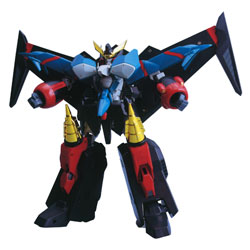
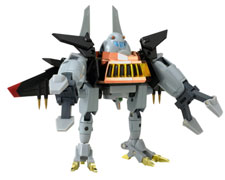
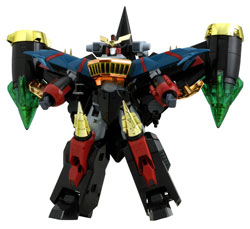
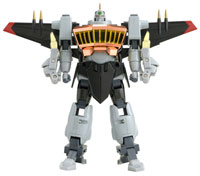
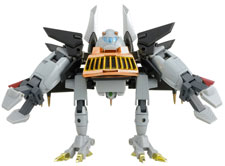


"Grendizer" is the titular mecha originated from the super robot show "UFO Robo Grendizer," created by the manga artist Go Nagai. "Grendizer" was created by the Vegan Empire and stolen by the Prince of Planet Fleed, who piloted it under the guise of the masked warrior Duke Fleed. "T.O.P Collection No. 6 - Grendizer" is an 8 ½" tall PVC figure fully painted and comes in a window box. 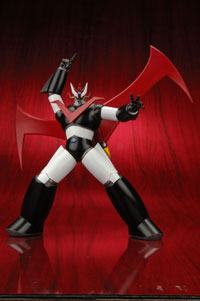
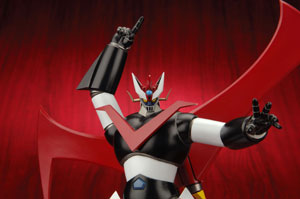
“AV-0 Zerosiki Peacemaker & Brave Gokin 14 - AV-98 Ingram 01, 02 & 03 (Reactive Armor Version) are also planned for Winter 2008. "AV-0 Zerosiki Peacemaker (or AV-X0 Zerosiki)," is based on the famous Anime action series "Patlabor, Mobile Police." "AV-0 Zerosiki Peacemaker (or AV-X0 Zerosiki)" is a 7" PVC/ABS/PC figure and has multiple articulation points. The figure comes equipped with replaceable/interchangeable parts/weapons. "AV-0 Zerosiki Peacemaker" will be available in February with a SRP of $75.00. 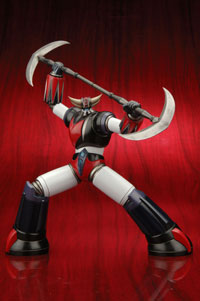
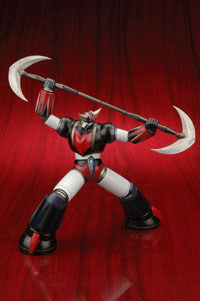
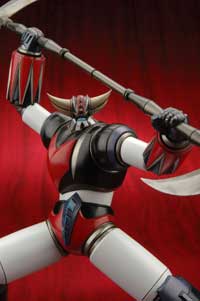
"Ingram 01, 02 & 03 (Reactive Armor Version)," is based on the famous Anime action series "Patlabor, Mobile Police." "Brave Gokin 14 AV-98 Ingram 01, 02 & 03 (Reactive Armor Version)" is a (one) 7" DIECAST/PVC/ABS/PC figure and has multiple articulation points. The figure comes equipped with replaceable/interchangeable parts/weapons which allow you to create either Ingram 01, Ingram 02 or Ingram 03. “Brave Gokin 14 - AV-98 Ingram 01, 02 & 03 (Reactive Armor Version)" will be available in March with a SRP of $145.00. 


5" collectible PVC figure “Hellsing Collection Figure – Search & Destroy (Vol. 1) Awaiting and Blood & Bats will be release in February for $25.00. 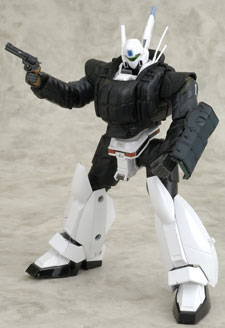
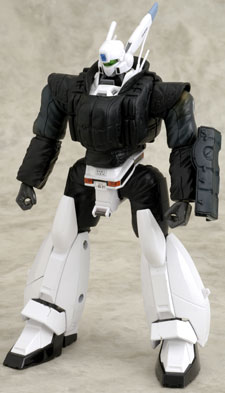
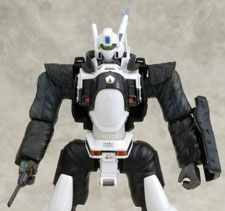
Figures.com/Cool Japanese Toys reviews Yamato SIF EX Ryofu Housen (Ikki Tousen), Yamato SIF EX Takase Mizuki (Comics Party) and Hasbro Transformers Masterpiece STARSCREAM 


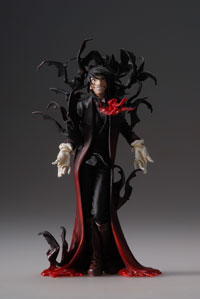
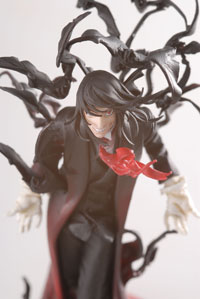
Anime Network Add New Titles, Broadband
Anime Newtwork's upcoming Video on Demmand offerings include Magikano, 5 Centimeters Per Second, Welcome to the NHK and Moonlight Mile Magikano starts January 3, 2008 Produced by Studio Gonzo (Welcome to the NHK, Afro Samurai) and directed by Seiji Kishi (Ragnarok The Animation), Magikano is a magical comedy about a middle school student who is seemingly ordinary, with the exception of his three witch sisters and his own soon-to-be-awakened mystical powers. Makoto Shinkai's 5 Centimeters Per Second and GONZO's geek comedy Welcome to the NHK start January 17, 2008. 5 Centimeters Per Second is the dramatic three-part tale of two best friends, their hidden feelings and their attempts to reunite after being separated by fate. Moonlight Mile premieres January 31, from Studio Hibari, this Sci-Fi adventure shares the chronicles of two mountain climbers-turned-space explorers as they trek into outer space, discover a new source of energy, and prepare to harness it as the next generation power supply for planet Earth. Anime Channel, also announced a new broadband service to stream high-quality anime on the Internet. This new service is free to the consumer, who can expect to find over 20 full episodes of classic and brand new anime series available at any given time. For the full range of Anime Network’s Internet offerings, visit www.theanimenetworkonline.com. Anime Network’s online programming is ad-supported, with five or more new episodes rotating through every Thursday. The Network’s lineup includes anime classics like Rahxephon and Saiyuki as well as new, ongoing series such as Ah! My Goddess: Flights of Fancy and Kurau Phantom Memory. Anime Network Online will present these series in their entirety over the coming months. Already more than 60,000 anime episodes have streamed since the beta launch in mid-November. Beginning today Anime Network will broadcast brand new series over the Internet, including series that have not yet been released on home video in North America. These “First Look” Internet broadcasts, which will begin running months before the DVD series is launched, will feature the Japanese language track with English subtitles and. Anime Network’s inaugural First Look program is the much-anticipated mecha series Gurren Lagann, from Studio GAINAX (Neon Genesis Evangelion). Anime Network’s streaming content is free and requires only the Flash 9 player and Java Script to view. As some of the programming is rated TV-MA, however, content is restricted to viewers 18 and older. At this time Anime Network’s Internet offerings are restricted to the US and Canada.
FUNimation Recalls My Santa
Anime News Network reports that FUNimation has recalled Itsudatte My Santa!, the anime adaptation of a Ken Akamatsu (Love Hina, Negima) Christmas manga. Though the DVD was labeled "TV-PG", it was intended to be TV-MA (mature audience only) to animated nudity and other content." The company plans to re-release the title for the 2008 holiday season.
Claymore Licensed?
A Geek By Any Other Name and WtW note that claimed to list FUNimation's planned releases for 2008 was pulled from Anime on DVD's forum. Especially eye raising was the listing that the distributor would be releasing volume one of the unannounced horror/fantasy/action Claymore on August 12th . None of this is confirmed, but other listings include Balder Force Ova in May DBZ Movies 1/2 Bluray on May 27th Dragonball GT Season 1 set on June 10th Dragonball Z season 5 remastered on May 27th Full Metal Panic (Second Raid) Boxset on May 20th Hana May 20th Sasami August 12th School Rumble Extra Class OVA June 17th School Rumble season 1 set, august 12th Shinobi Live Action Film HDDVD May 13th Teenage Mutant Ninja Turtles- Ninja Tribunal Set May 20th Tsubasa Season 2 Volume 1- August 19th
Early February ADV Releases
The following will be released by ADV Films on February 4, 2008Magikano: Witch Hunt Volume 2 of 3, also available in Collectors Edition with art box. Devil May Cry: The Animated Series Volume 1 of 3 Capcom is also releasing a special Devil May Cry 4 Collector’s Edition on February 5, including both Capcom’s new video game and the first volume of ADV’s anime series. The Collectors Edition sports an attractive Steelbook case holding the game, the anime DVD, and a bonus DVD including a “making of” feature on the new game and other game-related extras. Fans purchasing the Devil May Cry 4 Collector’s Edition will be able to enter their address at the ADV website to receive a volume 1 DVD case plus a coupon for $5 off volume 2 with the limited edition anime Collectors Box. Synopsis: His name is Dante. Half demon and half human, he is charged with ridding the world of the demons that plague it…for the right price. The doors to his business, Devil May Cry, are always open to those with money in pocket, and occasionally to some without. Dante is approached by a man named Morrison to deliver a young heiress Patty to her inheritance. He thinks it’s a job not worthy of his time – that is, until a group of demons intent on killing Patty crash the party. With guns drawn and sword ready by his side, Dante will have to mow down the opposition to delivery the mark and discover just who is behind the series of attacks. It’s only the beginning for this iconic character, as familiar faces and foes test their mettle against the crew of the Devil May Cry.
March From Media Blasters
Via Anime on DVD 3/4 Kite/Mezzo Forte Double Pack (Cut or Uncut) 3/18 Tweeny Witches Vol. #1 (also w/box) a tv series from Studio 4C, the animators behind Tekkon Kinkreet 3/25 Strawberry Panic Vol. #1 Kite: Liberator
Anime Torrent Downloading Estimated
ICV2 reports that according to Central Park Media's John O'Donnell, who hired the online metrics firm Media Defender to survey the online traffic in illegal anime downloads, there are six million anime downloads per week via the peer-to-peer BitTorrent protocol alone. This figure does not include downloads via newsgroups or Usenet.
Gerard Butler No Longer Priest
According to The Beat, the buzz out of the New York Anime Festival is that in the wake of 300's popularity, Gerard Butler will no longer star as the hero in the live action adaptation of Min-Woo Hyung's undead western manhwa Priest.
Mechademia 2: Networks of Desire Released
Networks of Desire—the second volume in the Mechademia series, an annual forum devoted to critical and creative work on Japanese anime, manga, and the fan cultures that have coalesced around them—explores the varieties of desire that structure and influence much of contemporary anime and manga in manifestations that range from the explicitly sexual to more sublimated text and imagery. Contributors: Brent Allison, Meredith Suzanne Hahn Aquila, Hiroki Azuma, William L. Benzon, Christopher Bolton, Martha Cornog, Patrick Drazen, Marc Hairston, Mari Kotani, Shu Kuge, Margherita Long, Daisuke Miyao, Hiromi Mizuno, Mariana Ortega, Timothy Perper, Eron Rauch, Trina Robbins, Brian Ruh, Deborah Shamoon, Masami Toku, Keith Vincent. For more information, including the table of contents, visit the book's webpage

